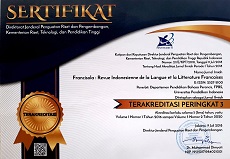Reactions on the Translation of Le Comte de Monte Cristo by Alexandre Dumas in Hikajat Siti Mariah by Hadji Moekti in Indonesian Literature in the Dutch Colonial Era
Abstract
RÉSUMÉ. La traduction du Comte de Monte Cristo d'Alexandre Dumas dans la littérature indonésienne coloniale européenne (1900-1942) n'a pas été seulement appréciée par le transfert de langue, la traduction de texte ou l'adaptation. La traduction a reçu une réaction avec la création de nouvelles œuvres littéraires qui sont devenues des œuvres littéraires indonésiennes «authentiques», comme Hikajat Siti Mariah (1910-1912). Divers problèmes répondaient à la construction textuelle du Comte de Monte Cristo. L'étude tente d'étudier la construction de l'identité représentée dans les deux textes à partir des paramètres narratifs, tels que l'espace, le genre, le corps et les relations raciales, dans une perspective postcoloniale. Les objets matériels sont Le Comte de Monte Cristo et Hikajat iti Mariah. L'objet formel est la réaction de la littérature indonésienne envers Le Comte de Monte Cristo. Les données de cette recherche sont le fond sociologique de ces œuvres littéraires, la naation coloniale dans ce texte et le discours colonial. L'interprétation des données se fait par lecture du modèle de déconstuction. Le résultat de cette recherche, la première, Le Comte de Monte Cristo renforce le romantisme et le matérialisme dans la construction de l'identité. La seconde, l'idée est rejetée par Hikajat Siti Mariah (1910-1912) qui construit une identité basée sur le spiritisme comme force humaine.
Mots-clés : identité, Hikajat Siti Mariah, Le Comte de Monte Cristo, traduction.
ABSTRACT. The translation of Le Comte de Monte Cristo by Alexandre Dumas in European colonial Indonesian literature (1900-1942) was not only appreciated through language transfer, text translation or adaptation. The translation received a reaction with the creation of new literary works that became "authentic" Indonesian literary works, such as Hikajat Siti Mariah (1910-1912). Various issues were responding to the textual construction of Le Comte de Monte Cristo. The study attempts to investigate the construction of the identity portrayed in the two texts from the narrative settings, such as space, gender, body, and race relations through a postcolonial perspective. The material object are Le Comte de Monte Cristo and Hikajat iti Mariah. The formal object is reaction Indonesia literature toward Le Comte de Monte Cristo Data this reseach are sociological backgrond this literary works, colonial naation in this text, and colonial discourse. The interpretation data is done by deconstuction model reading. The result this research , the first, Le Comte de Monte Cristo reinforces romanticism and materialism in the construction of identity. The second, the idea is rejected by Hikajat Siti Mariah (1910-1912) which constructs identity based on spiritualism as human strength.
Keywords: identity, Hikajat Siti Mariah, Le Comte de Monte Cristo, translation.
Full Text:
PDFReferences
Anjaria, U. (2012). Realism in thetwentieth centuryIndian novel; colonial difference and literary from. Cambridge: Cambridge University Press.
Bassnett, S., & Trivedi, H. (1999). Introduction of colonies, cannibals and vernaculars. In S. Bassnett & T. Hariss (Eds.), Post-Colonial Translation; Theory and Practice (Routledge). New York and London.
Chandra, E. (2011). Fantasizing Chinese/Indonesian Hero: Njoo Cheong Seng and the Gagaklodra Series. Archipel, 82, 83–113. https://doi.org/https://doi.org/10.3406/arch.2011.4256
Cheyfitz, E. (1991). The poetics of imperialism: Translation and colonization from the Tempest to Tarzan. New York and Oxford: : Oxford UniversityPress.
Clifford, J. (1988). The Predicament of culture. Cambridge, Mass: Harvard University Press.
Dracos, X. (1992). Histoire de la littérature française. Paris: Librairie Ha-chette. Paris: Librairie Ha-chette.
Faruk. (2007). Belenggu Pasca-Kolonial, Hegemoni dan Resistensi dalam Sastra Indonesia. Yogyakarta: Pustaka Pelajar.
Ghasemi, P., Sasani, S., & Nemat, F. (2018). Thirdspace, Hybridity, and Colonial Mimicy in Fugard’sBlood Knot. Khazar Journal of Humanities and Social Sciences, 21(1), 34–52. https://doi.org/10.5782/2223-2621.2018.21.1.34
Jedamski, D. (2002). Popular literature and postcolonial subjectivities Robinson Crusoe, the Count of Monte Cristo and Sherlock Holmes in colonial Indonesia. In K. Foulcher & T. Day (Eds.), Clearing a space , Postcolonial reading of modern Indonesian literature (pp. 19–47). Leiden: KITLV Press.
Klotz, V. (1979). Abenteuer-Romane; Sue, Dumas, Ferry, Ratcliffe, May, Verne. München/Wien: Hanser.
Krishnan, M. (2017). Introduction: Postcolonial space across forms. Journal of Postcolonial Writing, 53(6). https://doi.org/10.10.80/17449855.2017.1403069
Martins, M. P. (2017). Reflections the postcolonial novel: an interdisciplinarya pproach. International Journalof Humanities and Culture Studies, 4(2), 166–177.
Mills, S. (1993). Gender and Colonial Space. Gender, Place, and Culture, 3(2), 125–148. https://doi.org/10.1080/09663699650021855
Peck, J., & Coyle, M. (1993). Literary Terms and Criticism. London: Macmillan.
Russell, B. (2017). Sejarah filsafat Barat: kaitannya dengan kondisi sosio-politik zaman kuno hingga sekarang (translated; S. Jatmika, ed.). Yogyakarta: Pustaka Pelajar.
Salmon, C. (1994). Aux origines du roman malais moderne:Tjhit Liap Seng ou les Pleiades de L.K.H. Archipel, 48, 125–156.
Sharpe, J. (1995). Figure of colonial resistance. In B. Ashcroft (Ed.), InThe Post-Colonial Studies Reader (Routledge). London and New York.
Spivak, G. C. (2009). Outside in the teaching machine. New York and London: Routledge.
Upstone, S. (2009). Spatial Politics in the Postcolonial Novel. England: Ashgate Publishing Company.
Zacharias, R. (2015). Space and the Postcolonial novel. In A. Quayson (Ed.), The Cambridge Companion to the Postcolonial Novel (pp. 208–229). https://doi.org/10.1017/CB097813164.59287.013
DOI: https://doi.org/10.17509/francisola.v5i2.32240
Refbacks
- There are currently no refbacks.
Copyright (c) 2021 FRANCISOLA

This work is licensed under a Creative Commons Attribution-ShareAlike 4.0 International License.
View My Stats











